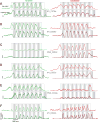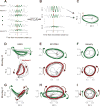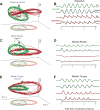Motor Cortex Embeds Muscle-like Commands in an Untangled Population Response
- PMID: 29398358
- PMCID: PMC5823788
- DOI: 10.1016/j.neuron.2018.01.004
Motor Cortex Embeds Muscle-like Commands in an Untangled Population Response
Abstract
Primate motor cortex projects to spinal interneurons and motoneurons, suggesting that motor cortex activity may be dominated by muscle-like commands. Observations during reaching lend support to this view, but evidence remains ambiguous and much debated. To provide a different perspective, we employed a novel behavioral paradigm that facilitates comparison between time-evolving neural and muscle activity. We found that single motor cortex neurons displayed many muscle-like properties, but the structure of population activity was not muscle-like. Unlike muscle activity, neural activity was structured to avoid "tangling": moments where similar activity patterns led to dissimilar future patterns. Avoidance of tangling was present across tasks and species. Network models revealed a potential reason for this consistent feature: low tangling confers noise robustness. Finally, we were able to predict motor cortex activity from muscle activity by leveraging the hypothesis that muscle-like commands are embedded in additional structure that yields low tangling.
Keywords: motor control; motor cortex; movement generation; neural dynamics; neural network; pattern generation; rhythmic movement.
Copyright © 2018 Elsevier Inc. All rights reserved.
Figures








Comment in
-
Untangling Neural Representations in the Motor Cortex.Neuron. 2018 Feb 21;97(4):736-738. doi: 10.1016/j.neuron.2018.02.012. Neuron. 2018. PMID: 29470966
References
-
- Evarts EV. Relation of pyramidal tract activity to force exerted during voluntary movement. J Neurophysiol. 1968;31:14–27. - PubMed
-
- Kakei S, Hoffman DS, Strick PL. Muscle and movement representations in the primary motor cortex. Science. 1999;285:2136–2139. - PubMed
-
- Georgopoulos AP, Schwartz AB, Kettner RE. Neuronal population coding of movement direction. Science. 1986;233:1416–1419. - PubMed
-
- Fetz EE, Cheney PD. Postspike facilitation of forelimb muscle activity by primate corticomotoneuronal cells. J Neurophysiol. 1980;44:751–772. - PubMed
Publication types
MeSH terms
Grants and funding
LinkOut - more resources
Full Text Sources
Other Literature Sources

